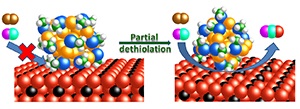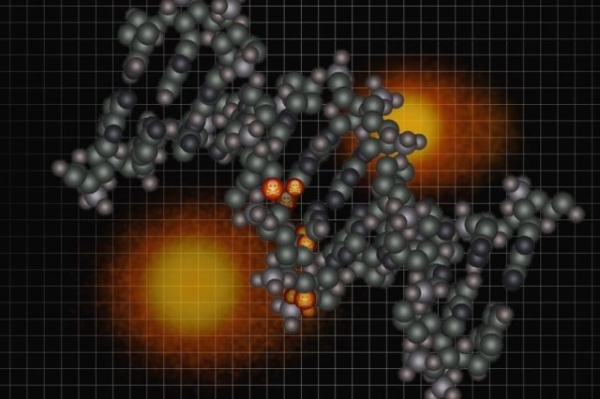The reaction mechanism of carbon monoxide oxidation is shown over intact and partially ligand-removed gold nanoclusters supported on cerium oxide rods. Image credit: Wu, Z.; Jiang, D.; Mann, A.; Mullins, D.; Qiao, Z.-A.; Allard, L.; Zeng, C.; Jin, R.; Overbury, S. Thiolate Ligands as a Double-Edged Sword for CO Oxidation on CeO2-Supported Au25(SCH2CH2Ph)18 Nanoclusters. J. Am. Chem. Soc. 2014, 136(16), 6111. (hi-res image)
Courtesy of Oak ridge National Labratory:
Old thinking was that gold, while good for jewelry, was not of much use for chemists because it is relatively nonreactive. That changed a decade ago when scientists hit a rich vein of discoveries revealing that this noble metal, when structured into nanometer-sized particles, can speed up chemical reactions important in mitigating environmental pollutants and producing hard-to-make specialty chemicals. Catalytic gold nanoparticles have since spurred hundreds of scientific journal articles. With the world catalyst market poised to hit $19.5 billion by 2016, gold nanoparticles may find commercial as well as intellectual importance, as they could ultimately lead to novel catalysts for energy, pharmacology and diverse consumer products.
But before gold nanoparticles can be useful to consumers, researchers have to make them both stable and active. Recently, scientists learned to make tiny, highly ordered clusters with very specific numbers of gold atoms that are stabilized by compounds called ligands. These stabilized gold clusters plus ligands may be thought of as large molecules. In collaboration with scientists from Carnegie Mellon University, researchers at the Department of Energy’s Oak Ridge National Laboratory have found one new gold molecule, a catalyst containing exactly 25 gold atoms, that is powerful as well as sophisticated. It catalyzes the conversion of a variety of molecules, including the transformation of poisonous carbon monoxide into harmless carbon dioxide, a reaction that may find application in devices near gas flues or wood-burning stoves. Unfortunately, the ligands that create and stabilize the engineered clusters also block the very sites needed to catalyze the conversion of carbon monoxide into carbon dioxide. Continue reading



